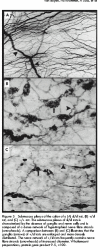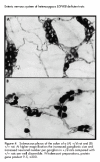Abnormalities of the enteric nervous system in heterozygous endothelin B receptor deficient (spotting lethal) rats resembling intestinal neuronal dysplasia
- PMID: 12171966
- PMCID: PMC1773371
- DOI: 10.1136/gut.51.3.414
Abnormalities of the enteric nervous system in heterozygous endothelin B receptor deficient (spotting lethal) rats resembling intestinal neuronal dysplasia
Abstract
Background: A homozygous mutation of the endothelin B receptor (EDNRB) gene in spotting lethal (sl/sl) rats leads to Hirschsprung's disease (HSCR) with long segmented aganglionosis. However, the effects on the development of the enteric nervous system (ENS) promoted by a heterozygous mutation of the EDNRB gene are not known. The present study aimed to describe and morphometrically assess the phenotypic abnormalities of the ENS in heterozygous (+/sl) EDNRB deficient rats in comparison with homozygous (sl/sl) EDNRB deficient and wild-type (+/+) rats.
Methods: The distal small intestine, caecum, and colon were obtained from sl/sl, +/sl, and +/+ rats. To demonstrate the three dimensional organisation of the ENS, the intestinal wall was microdissected into wholemounts and incubated against the pan-neuronal marker protein gene product 9.5. Assessment of the ENS included morphometric quantification of ganglionic size and density, the number of nerve cells per ganglia, and the diameter of nerve fibre strands within both the myenteric and submucous plexus.
Results: Sl/sl rats were characterised by complete aganglionosis resembling the same histopathological features observed in patients with HSCR. +/sl rats revealed more subtle abnormalities of the ENS: the submucous plexus was characterised by a significantly increased ganglionic size and density, and the presence of hypertrophied nerve fibre strands. Morphometric evaluation of the myenteric plexus did not show statistically significant differences between +/sl and +/+ rats.
Conclusions: In contrast with sl/sl rats, +/sl rats display non-aganglionated malformations of the ENS. Interestingly, these innervational abnormalities resemble the histopathological criteria for intestinal neuronal dysplasia (IND). Although IND has been described in several intestinal motility disorders, the concept of a clearly defined clinical-histopathological entity is still controversially discussed. The present findings support the concept of IND based on clearly defined morphological criteria suggesting a genetic link, and thus may provide a model for human IND. Furthermore, the data underline the critical role of the "gene dose" for the phenotypic effects promoted by the EDNRB/EDN3 system and confirm that the development of the ENS is not an "all or none" phenomenon.
Figures




Similar articles
-
Phenotype, intestinal morphology, and survival of homozygous and heterozygous endothelin B receptor--deficient (spotting lethal) rats.J Pediatr Surg. 2000 Mar;35(3):480-8. doi: 10.1016/s0022-3468(00)90218-5. J Pediatr Surg. 2000. PMID: 10726693
-
Transgenic expression of the endothelin-B receptor prevents congenital intestinal aganglionosis in a rat model of Hirschsprung disease.J Clin Invest. 1998 Sep 15;102(6):1092-101. doi: 10.1172/JCI3702. J Clin Invest. 1998. PMID: 9739043 Free PMC article.
-
Molecular genetics of colorectal motility disorders.Eur J Pediatr Surg. 2003 Jun;13(3):146-51. doi: 10.1055/s-2003-41767. Eur J Pediatr Surg. 2003. PMID: 12939697
-
[Disorders of intestinal innervation as a possible cause for chronic constipation].Zentralbl Chir. 1999;124(9):796-803. Zentralbl Chir. 1999. PMID: 10544485 Review. German.
-
Updated results on intestinal neuronal dysplasia (IND B).Eur J Pediatr Surg. 2004 Dec;14(6):384-91. doi: 10.1055/s-2004-821120. Eur J Pediatr Surg. 2004. PMID: 15630639 Review.
Cited by
-
A new experimental approach is required in the molecular analysis of intestinal neuronal dysplasia type B patients.Exp Ther Med. 2010 Nov;1(6):999-1003. doi: 10.3892/etm.2010.140. Epub 2010 Aug 26. Exp Ther Med. 2010. PMID: 22993632 Free PMC article.
-
Building a brain in the gut: development of the enteric nervous system.Clin Genet. 2013 Apr;83(4):307-16. doi: 10.1111/cge.12054. Epub 2012 Nov 27. Clin Genet. 2013. PMID: 23167617 Free PMC article. Review.
-
Endothelin receptor B-deficient mice are protected from high-fat diet-induced metabolic syndrome.Mol Metab. 2024 Feb;80:101868. doi: 10.1016/j.molmet.2023.101868. Epub 2023 Dec 28. Mol Metab. 2024. PMID: 38159882 Free PMC article.
-
Advances in understanding functional variations in the Hirschsprung disease spectrum (variant Hirschsprung disease).Pediatr Surg Int. 2017 Mar;33(3):285-298. doi: 10.1007/s00383-016-4038-3. Epub 2016 Dec 17. Pediatr Surg Int. 2017. PMID: 27988850 Review.
-
Altered neuronal density and neurotransmitter expression in the ganglionated region of Ednrb null mice: implications for Hirschsprung's disease.Neurogastroenterol Motil. 2013 Mar;25(3):e233-44. doi: 10.1111/nmo.12083. Epub 2013 Jan 29. Neurogastroenterol Motil. 2013. PMID: 23360229 Free PMC article.
References
-
- Garver KL, Garner B, Law JC. Hirschsprung's disease: a genetic study. Clin Genet 1985;26:261–77. - PubMed
-
- Skinner MA. Hirschsprung's disease. Curr Probl Surg 1996;33:389–460. - PubMed
-
- Kusafuka T, Puri P. Genetic aspects of Hirschsprung's disease. Semin Pediatr Surg 1998;7:148–55. - PubMed
-
- Meier-Ruge W. Causes of colon disorder with symptoms of Hirschsprung's disease. Verh Dtsch Ges Pathol 1971;55:506–10. - PubMed
-
- Borchard F, Meier-Ruge W, Wiebecke B, et al. (Disorders of the innervation of the large intestine-classification and diagnosis. Results of a consensus conference of the Society of Gastroenteropathology, 1 December 1990 in Frankfurt/Main). Pathologe 1991;12:171–4. - PubMed
MeSH terms
Substances
LinkOut - more resources
Full Text Sources
Medical
